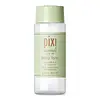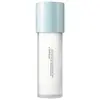What's inside
What's inside
 Key Ingredients
Key Ingredients

 Benefits
Benefits

 Concerns
Concerns

 Ingredients Side-by-side
Ingredients Side-by-side

Water
Skin ConditioningChamomilla Recutita Flower Water
MaskingPropanediol
SolventGlycerin
HumectantSimmondsia Chinensis Seed Oil
EmollientCaprylic/Capric Triglyceride
MaskingSodium PCA
HumectantAvena Strigosa Seed Extract
Skin ConditioningHydrolyzed Barley Protein
Skin ConditioningCamellia Sinensis Leaf Extract
AntimicrobialChamomilla Recutita Flower Extract
MaskingEuterpe Oleracea Sterols
Skin ConditioningLinoleic Acid
CleansingOleic Acid
EmollientLinolenic Acid
CleansingSodium Hyaluronate
HumectantCitrus Aurantium Dulcis Peel Extract
Emulsion StabilisingCitrus Nobilis Fruit Extract
MaskingRosa Damascena Flower Extract
MaskingVanilla Planifolia Fruit Extract
Skin ConditioningVitis Vinifera Fruit Extract
Skin ConditioningCitrus Limon Peel Extract
EmollientEugenia Caryophyllus Flower Extract
AstringentLavandula Angustifolia Flower/Leaf/Stem Extract
MaskingPhospholipids
Skin ConditioningLecithin
EmollientPEG-40 Hydrogenated Castor Oil
EmulsifyingPhenoxyethanol
PreservativePotassium Sorbate
PreservativeDisodium EDTA
Citric Acid
BufferingSodium Benzoate
MaskingBenzyl Alcohol
PerfumingSodium Citrate
BufferingXanthan Gum
EmulsifyingEthylhexylglycerin
Skin ConditioningWater, Chamomilla Recutita Flower Water, Propanediol, Glycerin, Simmondsia Chinensis Seed Oil, Caprylic/Capric Triglyceride, Sodium PCA, Avena Strigosa Seed Extract, Hydrolyzed Barley Protein, Camellia Sinensis Leaf Extract, Chamomilla Recutita Flower Extract, Euterpe Oleracea Sterols, Linoleic Acid, Oleic Acid, Linolenic Acid, Sodium Hyaluronate, Citrus Aurantium Dulcis Peel Extract, Citrus Nobilis Fruit Extract, Rosa Damascena Flower Extract, Vanilla Planifolia Fruit Extract, Vitis Vinifera Fruit Extract, Citrus Limon Peel Extract, Eugenia Caryophyllus Flower Extract, Lavandula Angustifolia Flower/Leaf/Stem Extract, Phospholipids, Lecithin, PEG-40 Hydrogenated Castor Oil, Phenoxyethanol, Potassium Sorbate, Disodium EDTA, Citric Acid, Sodium Benzoate, Benzyl Alcohol, Sodium Citrate, Xanthan Gum, Ethylhexylglycerin
Water
Skin ConditioningButylene Glycol
HumectantGlycerin
HumectantGlycereth-26
HumectantDipropylene Glycol
Humectant1,2-Hexanediol
Skin ConditioningPanthenol
Skin ConditioningPolyquaternium-51
Skin ConditioningPropanediol
SolventPPG-13-Decyltetradeceth-24
EmulsifyingAcrylates/C10-30 Alkyl Acrylate Crosspolymer
Emulsion StabilisingEthylhexylglycerin
Skin ConditioningTromethamine
BufferingCellulose Gum
Emulsion StabilisingDisodium EDTA
Hydrolyzed Hyaluronic Acid
HumectantParfum
MaskingBeta-Glucan
Skin ConditioningSodium Hyaluronate
HumectantLactobacillus Ferment Lysate
Skin ConditioningTocopherol
AntioxidantUndaria Pinnatifida Extract
Skin ConditioningWater, Butylene Glycol, Glycerin, Glycereth-26, Dipropylene Glycol, 1,2-Hexanediol, Panthenol, Polyquaternium-51, Propanediol, PPG-13-Decyltetradeceth-24, Acrylates/C10-30 Alkyl Acrylate Crosspolymer, Ethylhexylglycerin, Tromethamine, Cellulose Gum, Disodium EDTA, Hydrolyzed Hyaluronic Acid, Parfum, Beta-Glucan, Sodium Hyaluronate, Lactobacillus Ferment Lysate, Tocopherol, Undaria Pinnatifida Extract
 Reviews
Reviews

Ingredients Explained
These ingredients are found in both products.
Ingredients higher up in an ingredient list are typically present in a larger amount.
Disodium EDTA plays a role in making products more stable by aiding other preservatives.
It is a chelating agent, meaning it neutralizes metal ions that may be found in a product.
Disodium EDTA is a salt of edetic acid and is found to be safe in cosmetic ingredients.
Learn more about Disodium EDTAEthylhexylglycerin (we can't pronounce this either) is commonly used as a preservative and skin softener. It is derived from glyceryl.
You might see Ethylhexylglycerin often paired with other preservatives such as phenoxyethanol. Ethylhexylglycerin has been found to increase the effectiveness of these other preservatives.
Glycerin is already naturally found in your skin. It helps moisturize and protect your skin.
A study from 2016 found glycerin to be more effective as a humectant than AHAs and hyaluronic acid.
As a humectant, it helps the skin stay hydrated by pulling moisture to your skin. The low molecular weight of glycerin allows it to pull moisture into the deeper layers of your skin.
Hydrated skin improves your skin barrier; Your skin barrier helps protect against irritants and bacteria.
Glycerin has also been found to have antimicrobial and antiviral properties. Due to these properties, glycerin is often used in wound and burn treatments.
In cosmetics, glycerin is usually derived from plants such as soybean or palm. However, it can also be sourced from animals, such as tallow or animal fat.
This ingredient is organic, colorless, odorless, and non-toxic.
Glycerin is the name for this ingredient in American English. British English uses Glycerol/Glycerine.
Learn more about GlycerinPropanediol is an all-star ingredient. It softens, hydrates, and smooths the skin.
It’s often used to:
Propanediol is not likely to cause sensitivity and considered safe to use. It is derived from corn or petroleum with a clear color and no scent.
Learn more about PropanediolSodium Hyaluronate is hyaluronic acid's salt form. It is commonly derived from the sodium salt of hyaluronic acid.
Like hyaluronic acid, it is great at holding water and acts as a humectant. This makes it a great skin hydrating ingredient.
Sodium Hyaluronate is naturally occurring in our bodies and is mostly found in eye fluid and joints.
These are some other common types of Hyaluronic Acid:
Learn more about Sodium HyaluronateWater. It's the most common cosmetic ingredient of all. You'll usually see it at the top of ingredient lists, meaning that it makes up the largest part of the product.
So why is it so popular? Water most often acts as a solvent - this means that it helps dissolve other ingredients into the formulation.
You'll also recognize water as that liquid we all need to stay alive. If you see this, drink a glass of water. Stay hydrated!
Learn more about Water